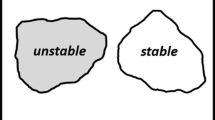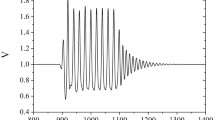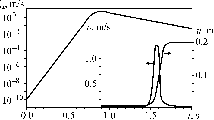Abstract
A plane fault containing two asperities subject to a constant strain rate by the motion of tectonic plates is considered. The fault is modelled as a discrete dynamical system where the average values of stress, friction and slip on each asperity are considered. The state of the fault is described by the slip deficits of the asperities. We study the behaviour of the system in the presence of stress perturbations that are supposed to be due to dislocations of neighbouring faults. The fault complexity entails consequences that are not present in the case of a homogeneous fault. A stress perturbation not only changes the occurrence time of the following earthquake but may also sensitively change the slip amplitude and area, hence the seismic moment, of the earthquake, as well as the position of its hypocentre. The greatest changes take place when simultaneous slip of asperities is involved. A Coulomb stress value can be assigned to each asperity. The change in the difference between the Coulomb stresses of the two asperities is a measure of how much the system gets closer to or farther from the condition for simultaneous slip. As an example, we consider the effect of the 1960 Great Chilean Earthquake on the two-asperity fault that produced the 2010 Maule earthquake and calculate the changes in the moment rate and in the total seismic moment. It results that, in the absence of the 1960 earthquake, the Maule earthquake would have occurred several decades later and would have involved a different sequence of modes, so that the moment rate function would have been very different, with a longer duration and a greater seismic moment.







Similar content being viewed by others
References
Amendola, A., and Dragoni, M., 2013. Dynamics of a two-fault system with viscoelastic coupling, Nonlin. Processes Geophys., 20, 1–10, doi:10.5194/npg-20-1-2013.
Belardinelli, M. E., Bizzarri, A. and Cocco, M., 2003. Earthquake triggering by static and dynamic stress changes, J. Geophys. Res., 108, No. B3, 2135, doi:10.1029/2002JB001779.
Campos J., Hatzfeld D, Madariaga R., Lopez G., Kausel E., Zollo A., Iannaccone G., Fromm R., Barrientos S., Lyon-Caen, H., 2002. A seismological study of the 1835 seismic gap in south-central Chile, Phys. Earth Planet. Inter., 132, 177–195.
Delouis, B., Nocque-t, J.-M. and Vallée M., 2010. Slip distribution of the February 27, 2010 Mw = 8.8 Maule earthquake, central Chile, from static and high-rate GPS, InSAR, and broadband teleseismic data, Geophys. Res. Lett., 37, L17305, doi:10.1029/2010GL043899.
de Sousa Vieira, M., 1995. Chaos in a simple spring-block system, Phys. Lett. A, 198, 407–414.
Dieterich, J., 1994. A constitutive law for rate of earthquake production and its application to earthquake clustering, J. Geophys. Res., 99, 2601–2618.
Ding, M. and Lin, J., 2014. Post-seismic viscoelastic deformation and stress transfer after the 1960 M9.5 Valdivia, Chile earthquake: effects on the 2010 M8.8 Maule, Chile earthquake, Geophys. J. Int., 2, 697–704, doi:10.1093/gji/ggu048.
Dragoni, M. and Santini, S., 2012. Long-term dynamics of a fault with two asperities of different strengths, Geophys. J. Int., 191, 1457–1467.
Dragoni, M. and Santini, S., 2014. Source functions of a two-asperity fault model, Geophys. J. Int., 196, 1803–1812.
Fujii, Y., and Satake, K., 2013. Slip distribution and seismic moment of the 2010 and 1960 Chilean earthquakes inferred from tsunami waveforms and coastal geodetic data, Pure Appl. Geophys., 170, 1493—1509.
Galvanetto, U., 2004. Sliding bifurcations in the dynamics of mechanical systems with dry friction - remarks for engineers and applied scientists, J. Sound Vib., 276, 121–139.
Gomberg, J., Beeler, N. and Blanpied, M., 2000. On rate-state and Coulomb failure models, J. Geophys. Res., 105, 7557–7871.
Harris, R. A., 1998. Introduction to special section: Stress triggers, stress shadows, and implications for seismic hazard, J. Geophys. Res., 103, 24, 347—24, 358.
He, C., 2003. Interaction between two sliders in a system with rate- and state-dependent friction, Sci. China, D, 46, 67–74.
Huang, J. and Turcotte, D. L., 1990. Are earthquakes an example of deterministic chaos?, Geophys. Res. Lett., 17, 223-226.
Huang, J. and Turcotte, D. L., 1992. Chaotic seismic faulting with mass-spring model and velocity-weakening friction, Pure Appl. Geophys., 138, 569–589.
Johanson, I.A., Fielding, E.J., Rolandone, F. and Bürgmann, R., 2006. Coseismic and postseismic slip of the 2004 Parkfield earthquake from space-geodetic data, Bull. Seismol. Soc. Am., 96, S269–S282, doi:10.1785/0120050818.
Kanamori, H and Cipar, J.J., 1974. Focal process of the Great Chilean Earthquake May 22, 1960, Phys. Earth Planet. Inter., 9, 128–136.
Kikuchi, M. and Kanamori, H., 1996. Rupture process of the Kobe, Japan, of Jan. 17, 1995, determined from teleseismic body waves, J. Phys. Earth, 44, 429–436.
Koketsu, K., Yoshida, S. and Higashihara, H., 1998. A fault model of the 1995 Kobe earthquake derived from the GPS data on the Akashi Kaikyo Bridge and other datasets, Earth Planets Space, 50, 803–811.
Lay T., Kanamori, H. and Ruff, L., 1982. The asperity model and the nature of large subduction zone earthquakes, Earthq. Pred. Res., 1, 3–71.
Lay, T., Ammon, C.J., Kanamori, H., Koper, K.D., Sufri, O. and Hutko, A.R., 2010. Teleseismic inversion for rupture process of the 27 February 2010 Chile (Mw 8.8) earthquake, Geophys. Res. Lett., 37, L13301.
McCloskey, J. and Bean, C. J., 1992. Time and magnitude predictions in shocks due to chaotic fault interactions, Geophys. Res. Lett., 19, 119–122.
Mendoza, C., Hartzell, S. and Monfret T., 1994. Wide-band analysis of the 3 March 1985 central Chile earthquake: Overall source process and rupture history, Bull. Seismol. Soc. Am., 84, 269–283.
Nussbaum, J. and Ruina, A., 1987. A two degree-of-freedom earthquake model with static/dynamic friction, Pure Appl. Geophys., 125, 629–656.
Plafker, G., and Savage, J. C., 1970. Mechanism of the Chilean earthquake of May 21 and 22, 1960, Geol. Soc. Am. Bull., 81, 1001–1030.
Pritchard, M. E., and Simons, M., 2006. An aseismic slip pulse in northern Chile and along-strike variations in seismogenic behavior, J. Geophys. Res., 111, B08405, doi:10.1029/2006JB004258.
Rice, J. R., 1993. Spatio-temporal complexity of slip on a fault, J. Geophys. Res., 98, 9885–9907.
Ruegg, J. C., Rudloff, A., Vigny, C., Madariaga, R., de Chabalier, J.B., Campos, J., Kausel, E., Barrientos, S. and Dimitrov, D., 2009. Interseismic strain accumulation measured by GPS in the seismic gap between Constitución and Concepción in Chile, Phys. Earth Planet. Inter., 175, 78–85, doi:10.1016/j.pepi.2008.02.015.
Ruff, L.J., 1992. Asperity distributions and large earthquake occurrence in subduction zones, Tectonophysics, 211, 61–83.
Ruina, A., 1983. Slip instability and state variable friction laws, J. Geophys. Res., 88, 10359–10370.
Scholz, C. H., 1990. The Mechanics of Earthquakes and Faulting, Cambridge University Press, Cambridge.
Steacy, S., Gomberg, J., Cocco, M., 2005. Introduction to special section: Stress transfer, earthquake triggering, and time-dependent seismic hazard, J. Geophys. Res., 110, B05S01, doi:10.1029/2005JB003692.
Stein, R. S., 1999. The role of stress transfer in earthquake occurrence, Nature, 402, 605–609.
Stein, R.S., King, G.C.P. and Lin, J., 1992. Change in failure stress on the southern San Andreas fault system caused by the 1992 magnitude = 7.4 Landers earthquake, Science, 258, 1328–1332.
Turcotte, D. L., 1997. Fractals and Chaos in Geology and Geophysics, 2nd edition, Cambridge University Press, Cambridge.
Twardzik, C., Madariaga, R., Das, S. and Custódio, S., 2012. Robust features of the source process for the 2004 Parkfield, California, earthquake from strong-motion seismograms, Geophys. J. Int., 191, 1245–1254.
Vigny, C., Socquet A., Peyrat S., Ruegg J.-C., Métois M., Madariaga R., Morvan S., Lancieri M., Lacassin R., Campos J., Carrizo D., Bejar-Pizarro M., Barrientos S., Armijo R., Aranda C., Valderas-Bermejo M.-C., Ortega I., Bondoux F., Baize S., Lyon-Caen H., Pavez A., Vilotte J.P., Bevis M., Brooks B., Smalley R., Parra H., Baez J.-C., Blanco M., Cimbaro S., Kendrick E., 2011. The 2010 Mw 8.8 Maule megathrust earthquake of Central Chile, monitored by GPS, Science, 332, 1417–1421, doi:10.1126/science.1204132.
Acknowledgments
The authors are grateful to the editor Eugenio Carminati and to two anonymous reviewers for useful comments and suggestions on the first version of the paper.
Author information
Authors and Affiliations
Corresponding author
Rights and permissions
About this article
Cite this article
Dragoni, M., Piombo, A. Effect of Stress Perturbations on the Dynamics of a Complex Fault. Pure Appl. Geophys. 172, 2571–2583 (2015). https://doi.org/10.1007/s00024-015-1046-5
Received:
Revised:
Accepted:
Published:
Issue Date:
DOI: https://doi.org/10.1007/s00024-015-1046-5




